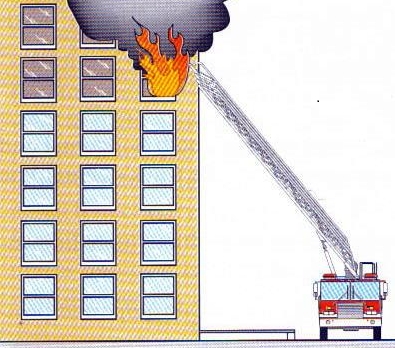Topic 4 Radicals and Rational Exponents
4.1 Do You Want to Be a Fire Fighter
To reach the 5th floor window of a building that is 25 feet from the location of the turntable aerial ladder truck. How long should the ladder be placed to reach the window? The hight of that window is 50 feet.

4.2 Radical Expressions
If , then we say that is a square root of . We denote the positive square root of as , called the principal square root.
For any real number , the expression can be simplified as
If , then we say that is a cube root of . The cube root of a real number is denoted by .
For any real number , the expression can be simplified as
In general, if , then we say that is an -th root of . If is even, the positive -th root of , called the principal -th root, is denoted by . If is odd, the -the root of has the same sign with .
In , the symbol is called the radical sign, is called the radicand, and is called the index.
If is even, then the -th root of a negative number is not a real number.
For any real number , the expression can be simplified as
- if is even.
- if is odd.
A radical is simplified if the radicand has no perfect power factors against the radical.
Example 4.1 Simplify the radical expression using the definition.
Solution.
- .
- .
4.3 Rational Exponents
If is a real number, then we define as
Rational exponents have the same properties as integral exponents:
Example 4.2 Simplify the radical expression or the expression with rational exponents. Write in radical notation.
Solution.
In general, rewriting radical in rational exponents helps simplify calculations.
4.4 Product and Quotient Rules for Radicals
If and are real numbers, then
If and are real numbers and , then
Example 4.3 Simplify the expression.
- .
- .
Solution.
- .
- .
4.5 Combining Like Radicals
Two radicals are called like radicals if they have the same index and the same radicand. We add or subtract like radicals by combining their coefficients.
Example 4.4 Simplify the expression.
Solution.
4.6 Multiplying Radicals
Multiplying radical expressions with many terms is similar to that multiplying polynomials with many terms.
Example 4.5 Simplify the expression.
Solution.
4.7 Rationalizing Denominators
Rationalizing denominator means rewriting a radical expression into an equivalent expression in which the denominator no longer contains radicals.
Example 4.6 Rationalize the denominator.
Solution.
- In this case, to get rid of the radical in the bottom, we multiply the expression by so that the radicand in the bottom becomes a perfect power.
- In this case, we use the formula . Multiply the expression by .
4.8 Complex Numbers
The imaginary unit is defined as . Hence .
If is a positive number, then .
Let and are two real numbers. We define a complex number by the expression . The number $a $ is called the real part and the number is called the imaginary part. If , then the complex number is just the real number. If , then we call the complex number an imaginary number. If and , then the complex number is called a purely imaginary number.
Adding, subtracting, multiplying, dividing or simplifying complex numbers are similar to those for radical expressions. In particular, adding and subtracting become similar to combining like terms.
Example 4.7 Simplify and write your answer in the form , where and are real numbers and is the imaginary unit.
Solution.
Example 4.8 Evaluate the express for . Write your answer in the form .
Solution.
4.9 Practice
Problem 4.1 Evaluate the square root. If the square root is not a real number, state so.
Problem 4.2 Simplify the radical expression.
Problem 4.3 Simplify the radical expression.
Problem 4.4 Simplify the radical expression. Assume all variables are positive.
Problem 4.5 Write the radical expression with rational exponents.
Problem 4.6 Write in radical notation and simplify.
Problem 4.7 Simplify the expression. Write with radical notations. Assume all variables represent nonnegative numbers.
Problem 4.8 Simplify the expression. Write in radical notation. Assume is nonnegative.
Problem 4.9 Simplify the expression. Write in radical notation. Assume is nonnegative.
Problem 4.10 Simplify the expression. Write in radical notation. Assume all variables are nonnegative.
Problem 4.11 Multiply and simplify.
Problem 4.12 Simplify the radical expression. Assume all variables are positive.
Problem 4.13 Divide. Assume all variables are positive. Answers must be simplified.
Problem 4.14 Add or subtract, and simplify. Assume all variables are positive.
Problem 4.15 Add or subtract, and simplify. Assume all variables are positive
Problem 4.16 Multiply and simplify. Assume all variables are positive.
Problem 4.17 Multiply and simplify. Assume all variables are positive.
Problem 4.18 Simplify the radical expression and rationalize the denominator. Assume all variables are positive.
Problem 4.19 Simplify the radical expression and rationalize the denominator. Assume all variables are positive.
Problem 4.20 Simplify and rationalize the denominator. Assume all variables are positive.
Problem 4.21 Add, subtract, multiply complex numbers and write your answer in the form .
Problem 4.22 Add, subtract, multiply complex numbers and write your answer in the form .
Problem 4.23 Divide the complex number and write your answer in the form .
Problem 4.24 Simplify the expression.
Problem 4.25 Evaluate the function polynomial for . Write your answer in the form .
Problem 4.26 Evaluate the polynomial for . Write your answer in the form .